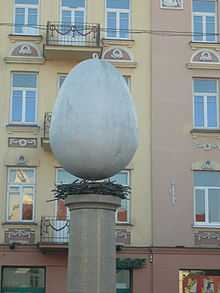Užupis



Užupis (Belarusian: Зарэчча, Polish: Zarzecze, Russian: Заречье) is a neighborhood in Vilnius, the capital of Lithuania, largely located in Vilnius' old town, a UNESCO World Heritage Site. Užupis means "on the other side of the river" in the Lithuanian language and refers to the Vilnia River; the name Vilnius was derived from the Vilnia. The district has been popular with artists for some time, and has been compared to Montmartre in Paris and to Freetown Christiania in Copenhagen, due to its bohemic and laissez-faire atmosphere. On April 1, 1997, the district declared itself an independent republic (The Republic of Užupis).
Geography
Užupis is quite small and isolated, being only about 148 acres (0.60 km2) in size; it has around 7,000 inhabitants, nearly 1,000 being artists. On one side it is separated from the Old Town by the Vilnia River, on the second there are steep hills, and on the third side it borders on an industrial area built under soviet rule, which is now to be rebuilt into a fashionable district. The first bridges across the river were built in the 16th century, at which time the district's inhabitants were mostly Jewish.
History

The district contains the Bernardine Cemetery, one of the oldest cemeteries in the city. Most of the district's Jewish population were killed during the Holocaust, and later the old Jewish Cemetery uphill would be destroyed by the Soviets. The houses left abandoned were later occupied by marginal elements of society, mainly the homeless and prostitutes. Until Lithuania's declaration of independence in 1990, it was one of the most neglected areas in the city, containing many run-down houses, many without utilities. The district has been a common haunt of artists and bohemians since Soviet times, and even today many young artists are squatting in abandoned buildings near the Vilnia River. 2013 saw the inauguration of two big art centers by the river and by the gymnasium.
The Republic of Užupis


In 1997, the residents of the area declared the Republic of Užupis, along with its own flag, currency, president, cabinet of ministers, a constitution written by Romas Lileikis and Thomas Chepaitis, an anthem, and an army (numbering approximately 11 men).[1] They celebrate this independence annually on Užupis Day, which falls on April 1. Artistic endeavours are the main preoccupation of the Republic; the current President of the Republic of Užupis, Romas Lileikis, is himself a poet, musician, and film director.
Artūras Zuokas, mayor of Vilnius, lives in Užupis and frequently takes part in the Republic's events. Užupis does not house internet-cafes, kiosks, big malls, or governmental institutions (except Užupian), and there is no embassy to Lithuania.
It is unclear whether the statehood of the Republic, recognized by no government, is intended to be serious, tongue-in-cheek, or a combination of both. The decision to place Užupis Day on April 1 (April Fools' Day) may not be coincidental, emphasizing the importance of humor and non-importance of "serious" political decisions.
Constitution of Užupis

Copies of the 39 articles of the Republic's constitution and 3 mottos - "Don't Fight", "Don't Win", "Don't Surrender" - in fifteen languages, can be found affixed to a wall on Paupio street in the area. Some of these articles would be unremarkable in a constitution; for instance, Article 5 simply reads "Man has the right to individuality.". Others are more idiosyncratic; a typical example can be found in Articles 1 ("People have the right to live by the River Vilnelė, while the River Vilnelė has the right to flow past people."), 12 ("A dog has the right to be a dog.") and 37 ("People have the right to have no rights."), each of which makes an unusual apportionment of rights. There are a number of paired articles, such as Articles 16 ("People have the right to be happy.") and 17 ("People have the right to be unhappy.") which declare people's right to either do or not do something, according to their desire.[2] The flag of the Republic consist one - a white background with the palm of hand, but each season the palm emblem has another color: Winter - blue, Spring - green, Summer - yellow, Autumn - red.[3]
Angel of Užupis

On April 1, 2002, a statue of the archangel Gabriel blowing a trumpet was unveiled in the main square. It was intended to symbolize the revival and artistic freedom of eastern Europe[citation needed]. The sculptor, Romas Vilčiauskas, is also the creator of the Užhupis Mermaid.[4]
Previously, a temporary sculpture of an egg stood in its place. The egg itself became the subject of various anecdotes. After being replaced by the larger statue of Gabriel, the egg was sold at an auction for 10,200 litas and now stands on Pylimo street.
Notable residents
Notable people who have resided in Užupis include:
- Felix Dzerzhinsky, also known as Iron Felix— a Soviet statesman and a prominent member of Polish and Russian revolutionary movements
- The painter and composer Mikalojus Konstantinas Čiurlionis
- Polish romantic-comic poet Konstanty Ildefons Galczynski lived here in 1934-36, his daughter Kira was born in Užupis
- Jurgis Kunčinas, author of 2 novels about Užupis, and translator from German
- Artūras Zuokas, current Vilnius mayor lives in Užupis
References
External links
- They tore down Lenin's statue - and raised one to Frank Zappa, article in Guardian Unlimited
- Užupis case study at Exchange Network for Sustainable Urban Revitalisation Experience
- Meeting the president of Užupis, video
- Video report about Vilnius, featuring a lot of scenes filmed in Užupis : Locks on bridges, the Republic and the Constitution
Coordinates: 54°40′50″N 25°17′49″E / 54.68056°N 25.29694°E